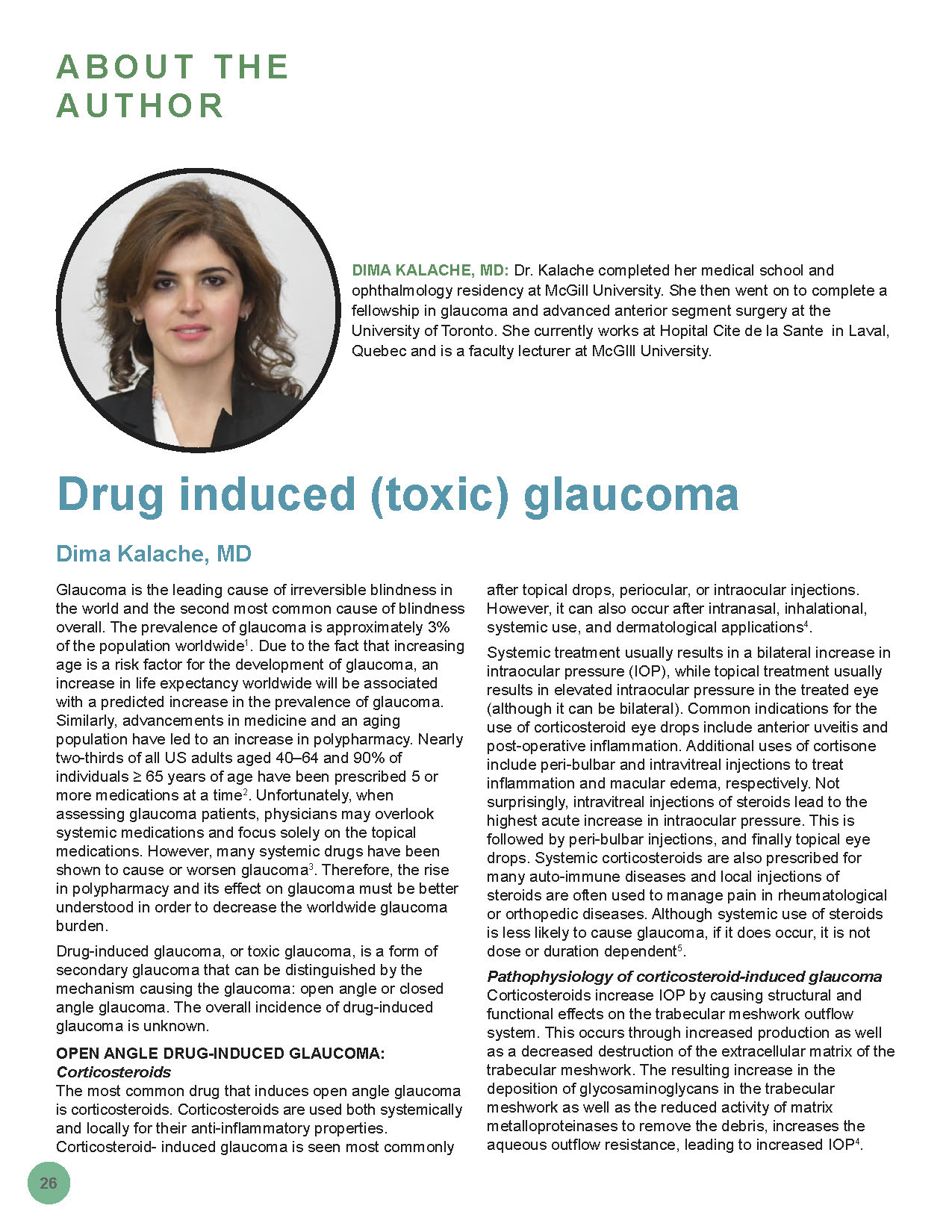Drug-induced (toxic) glaucoma
DOI:
https://doi.org/10.58931/cect.2022.1214Abstract
Glaucoma is the leading cause of irreversible blindness in the world and the second most common cause of blindness overall. The prevalence of glaucoma is approximately 3% of the population worldwide. Due to the fact that increasing age is a risk factor for the development of glaucoma, an increase in life expectancy worldwide will be associated with a predicted increase in the prevalence of glaucoma. Similarly, advancements in medicine and an aging population have led to an increase in polypharmacy. Nearly two-thirds of all US adults aged 40–64 and 90% of individuals ≥ 65 years of age have been prescribed 5 or more medications at a time. Unfortunately, when assessing glaucoma patients, physicians may overlook systemic medications and focus solely on the topical medications. However, many systemic drugs have been shown to cause or worsen glaucoma. Therefore, the rise in polypharmacy and its effect on glaucoma must be better understood in order to decrease the worldwide glaucoma burden.
Drug-induced glaucoma, or toxic glaucoma, is a form of secondary glaucoma that can be distinguished by the mechanism causing the glaucoma: open angle or closed angle glaucoma. The overall incidence of drug-induced glaucoma is unknown.
References
Flaxman SR, Bourne RRA, Resnikoff S, Ackland P, Braithwaite T, Cicinelli MV, et al. Global causes of blindness and distance vision impairment 1990–2020: A systematic review and meta-analysis. Lancet Glob Health. 2017 Dec;5(12):e1221-e1234. doi:10.1016/S2214-109X(17)30393-5. DOI: https://doi.org/10.1016/S2214-109X(17)30393-5
Charlesworth CJ, Smit E, Lee DS, Alramadhan F, Odden MC. Polypharmacy among adults aged 65 years and older in the United States: 1988–2010. J Gerontol A Biol Sci Med Sci. 2015;70:989–95. DOI: https://doi.org/10.1093/gerona/glv013
Ah-Kee EY, Egong E, Shafi A, Lim LT, Yim JL. A review of drug-induced acute angle closure glaucoma for non-ophthalmologists. Qatar Med J. 2015 May 10;2015(1):6. doi:10.5339/qmj.2015.6 DOI: https://doi.org/10.5339/qmj.2015.6
Feroze KB, Khazaeni L. Steroid Induced Glaucoma. In: StatPearls [Internet]. Treasure Island (FL): StatPearls Publishing; 2022 Jan. [Updated 2022 Mar 1].
Godel V, Feiler-Ofry V, Stein R. Systemic steroids and ocular fluid dynamics. II. Systemic versus topical steroids. Acta Ophthalmol (Copenh) 1972;50(5):664–676. DOI: https://doi.org/10.1111/j.1755-3768.1972.tb06607.x
Becker B. Intraocular pressure response to topical corticosteroids. Invest Ophthalmol Vis Sci. 1965 Apr;4:198–205.
Armaly MF. Statistical attributes of the steroid hypertensive response in the clinically normal eye.I. The demonstration of three levels of response. Invest Ophthalmol Vis Sci. 1965 Apr;4:187–197.
Espildora J, Vicuna P, Diaz E. Cortisone-induced glaucoma: a report on 44 affected eye. J Fr Ophthalmol. 1981;4(6-7):503–508.
Frenkel RE, Mani L, Toler AR, Frenkel MP. Intraocular pressure effects of pegaptanib (Macugen) injections in patients with and without glaucoma. Am J Ophthalmol. 2007 Jun;143(6):1034-5. doi:10.1016/j.ajo.2007.01.052 DOI: https://doi.org/10.1016/j.ajo.2007.01.052
Good TJ, Kimura AE, Mandava N, Kahook MY. Sustained elevation of intraocular pressure after intravitreal injections of anti-VEGF agents. Br J Ophthalmol. 2011 Aug;95(8):1111-4. doi:10.1136/bjo.2010.180729 DOI: https://doi.org/10.1136/bjo.2010.180729
Zhou Y, Zhou M, Xia S, et al. Sustained elevation of intraocular pressure associated with intravitreal administration of anti-vascular endothelial growth factor: a systematic review and meta-analysis. Sci Rep. 2016;6:39301. DOI: https://doi.org/10.1038/srep39301
Levin AM, Chaya CJ, Kahook MY, Wirostko BM. Intraocular Pressure Elevation Following Intravitreal Anti-VEGF Injections: Short- and Long-term Considerations. J Glaucoma. 2021 Dec 1;30(12):1019-1026. doi:10.1097/IJG.0000000000001894 DOI: https://doi.org/10.1097/IJG.0000000000001894
Fan JT, Johnson DH, Burk RR. Transient myopia, angle-closure glaucoma, and choroidal detachment after oral acetazolamide Am J Ophthalmol 1993 Jun;115(6):813-4. DOI: https://doi.org/10.1016/S0002-9394(14)73654-2
Fraunfelder FW, Fraunfelder FT, Keates EU. Topiramate associated acute, bilateral, secondary angle-closure glaucoma. 81. Ophthalmology 2003. DOI: https://doi.org/10.1016/j.ophtha.2003.04.004
Tripathi et al, Drug Induced Glaucomas Mechanism and Management. Drug Safety 2003;26 (11):749-767. DOI: https://doi.org/10.2165/00002018-200326110-00002
Phulke S, Kaushik S, Kaur S, Pandav SS. Steroid-induced Glaucoma: An Avoidable Irreversible Blindness. J Curr Glaucoma Pract. 2017;11(2):67-72. doi:10.5005/jp-journals-l0028-1226 DOI: https://doi.org/10.5005/jp-journals-10028-1226

Published
How to Cite
Issue
Section
License
Copyright (c) 2022 Canadian Eye Care Today

This work is licensed under a Creative Commons Attribution-NonCommercial-NoDerivatives 4.0 International License.
